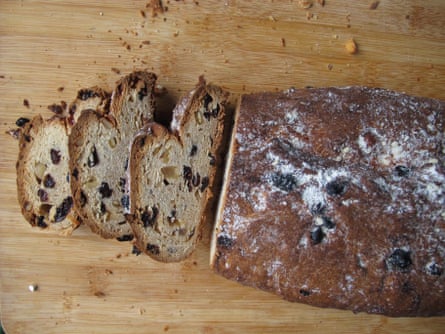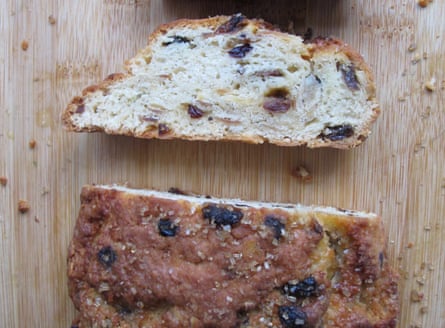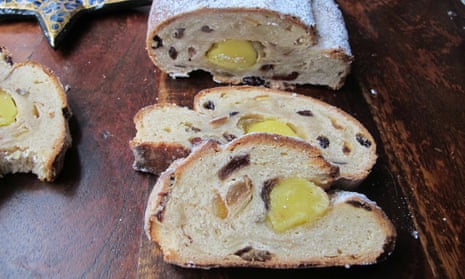Christmas is the one time of year when our stomachs can rest blessedly free from the vagaries of fashion – even people who’ve spent the last 12 months dining exclusively on kimchi and salted caramel cronuts are happy to sit down on 25 December to a menu that hasn’t changed all that much since the 18th century. But, although change for the sake of it is to be frowned upon (and I’ll die before I admit bacon has any place in a trifle), some new traditions are to be welcomed with open arms.
The Guardian’s product and service reviews are independent and are in no way influenced by any advertiser or commercial initiative. We will earn a commission from the retailer if you buy something through an affiliate link. Learn more.
Personally, Italian panettone leaves me cold; more Germanic imports, stodgier and richer, fit in much better with the British weather. Chief among these recent additions, as far as I’m concerned, is stollen, a richly fruited bread from Dresden, often spiked with the familiar flavour of marzipan, making it like the decadent love child of a hot cross bun and a festive fruit cake. I can’t get enough of the stuff, but – although it’s perfectly possible to buy very decent examples from certain discount supermarkets – it’s one of those things that is even better made at home, and not just because it makes the whole house smell of Christmas.

Flour
The two German recipes I try – from Luisa Weiss’s Classic German Baking and the lovely A Sausage Has Two blog – call for plain flour, as does Martha Stewart, while the Serious Eats version uses strong bread flour. Generally speaking, of course, the latter, with its higher protein content, is the better bet for bread, as the extra gluten gives dough a stronger, more elastic structure. But stollen is no ordinary bread; in fact, it’s supposed to be fairly dense and tight, which means that plain flour seems the way to go here.
Doves Farm, producers of various organic flours, give a recipe for stollen using wheat, rye and einkorn flour on its blog, which sounds pleasingly Germanic. This is one recipe where you can get away with substituting heavier flours, given the results will never be featherlight, but although it definitely tastes interesting, it doesn’t taste like stollen to me: “A bit worthy,” says one tester, going in for another piece.
I’ll be starting my stollen with a very quick pre-ferment, in which the yeast, flour and milk are left to their own devices for 30 minutes, as in the Serious Eats recipe. I think it gives the loaf a more complex flavour (although its poor rise suggests I probably overheated the milk and managed to kill off half the yeast) – you can leave it longer if you like, but half an hour seems just about doable at this frenetic time of year.
Raising agent
More modern stollen recipes sometimes use baking powder instead of the traditional yeast, which makes their preparation much quicker. Indeed, quarkstollen, where the low-fat fresh cheese is added to the dough to add “moisture and tenderness” in Weiss’s words, is almost always made like this (note: if time is of the essence and you can’t find quark, Stewart goes for the more widely available ricotta instead). This is certainly handy if you have a yen for instant gratification, but the baking powder versions lack the depth of flavour of the yeast-raised ones, so it’sdefinitely a compromise.

The butter and eggs
There is no getting away from the fact that stollen is a decadent proposition, designed to celebrate one of the biggest feasts in the church year, and the amount of butter that goes into it may raise a few eyebrows. The two richest recipes I try come from A Sausage Has Two and Serious Eats, which both use a ratio of about one part butter to three parts flour – an amount so large that, making the first, I’m moved to double check it before pouring it in (melting the butter, as A Sausage Has Two and Doves Farm suggest, proves easier than rubbing it into the dough, as in the other recipes). It is no coincidence that these two have the softest textures and the richest flavours, so I am afraid you will have to accept the inevitable and slice it more thinly if this concerns you. In the same spirit, Serious Eats’s egg yolks, rather than whole eggs, will give the dough a more tender crumb and a deeper colour and flavour.
Interestingly, A Sausage Has Two calls for the dry dough to rest for 40 minutes before adding the butter, although at this point it looks only half finished, and surrounded by unincorporated flour. I suspect this is because too much fat can stop the bread from rising, but since this doesn’t seem to be a problem in the Doves Farm version – and since I am already using a pre-ferment and would like to keep the stages to a minimum – I’m not going to bother.

The flavourings
Sugar is a must in stollen, but the amounts vary wildly, with Doves Farm using a ratio of 1:13 sugar to flour and Stewart confirming the idea that Americans have a sweet tooth by sticking in more than six times that amount. Although her bread is lovely, it is very sweet in comparison with many of the others, and testers decide they prefer the contrast between a more savoury crumb and the plump, sweet fruit within, so my stollen will be towards the more austere end of the spectrum.
The spices you choose to include are largely up to you (one of the joys of making this at home) but, to give an idea of the options available, A Sausage Has Two and Doves Farm use vanilla, Stewart cardamon and mace and Doves Farm mixed spice. (Interestingly, Weiss eschews any spices: clearly, this is a plainer affair than your average British festive bake.) Predictably, I like nutmeg and cardamom, but feel free to pick your own favourite poison.

Fruit and nuts
Although fruit isn’t a must either – Weiss goes for nuts and lemon zest alone – I love the pops of juicy sweetness it offers, especially when soaked in booze or clementine juice (as in the Doves Farm recipe) beforehand. Dark rum seems to be the most popular choice, suggesting the Germans have a taste for the tropical, but Serious Eats’s bourbon and Doves Farm’s brandy both work perfectly well if you don’t happen to have anything else knocking about. Again, the mixture of fruit is largely up to you, although I like a variety of colours and textures in mine and a good handful of candied peel (if you’re averse to the latter, feel free to substitute some freshly grated lemon or orange zest or to eschew citrus altogether).
Almonds, although not mandatory, add a pleasant crunch. Weiss uses them ground as well, which tastes lovely but, in the heavier, more buttery dough I’m planning, would probably sink any chances of it rising even slightly. If you’d like even more of an almond flavour, Stewart’s almond essence is a clever addition, although I prefer to get mine through the addition of a snake of marzipan. This is definitely optional – the oldest recipes don’t include it – but, really, why wouldn’t you?

Shaping, cooking and glazing
As the pictures prove, explaining how to shape a stollen is more difficult than actually doing it – in fact, I suspect a line must have been missed out of Weiss’s recipe, because I do nothing more than roll it out and stick it in the oven, from where it emerges an hour later, a solid, if tasty, brick. It’s easiest, I think, to watch it being done.
Don’t be tempted to overbake it: stollen is better a bit squidgy than dry and crusty. Traditionally, it is glazed with several layers of melted butter and icing sugar to keep it fresh – because this is definitely what it needs at this point – and then matured for at least a week before consumption. I dare you to try to keep it that long.
The perfect stollen

Makes 1 stollen
100g dried fruit of your choice (I like sultanas, currants and morello cherries)
2 tbsp dark rum or other spirit
160ml whole milk
3 tsp dried active yeast
425g plain flour, plus 1 tbsp
150g butter, plus 2 tbsp to glaze
50g caster sugar
1 level tsp fine salt
½ tsp ground nutmeg or other spice of your choice
2 egg yolks
25g mixed peel
150g marzipan
25g flaked almonds
4 tbsp icing sugar
Put the fruit in a bowl with the rum, cover and leave to soak. Meanwhile, heat the milk until just warm. Whisk together the yeast and extra 1 tbsp of flour then whisk in the milk and leave to sit for between 30 minutes and an hour until the top is covered with a mass of tiny bubbles. While it is fermenting, melt the butter (except for the extra 2 tbsp) and set aside to cool slightly.
Mix the remaining flour, sugar, salt and spice in a large mixing bowl and then pour in the milk mixture along with the yolks. Mix well, then stir in the melted butter until you have a coherent dough. Turn out on to a clean surface and knead for about 8-10 minutes until smooth and slightly elastic. Cover and set aside somewhere warm for about an hour until slightly risen.
Turn out on a lightly floured surface and knead in the soaked fruit – discarding (or consuming) any liquid that hasn’t been absorbed – plus the mixed peel and nuts until well dispersed. Put back into the bowl, cover and leave for another 30 minutes.
Turn out on the same surface and flatten into a rough oval shape, then use a rolling pin to make a trench down the length of the oval, about a third of the way in. Fold in the two ends of the trench slightly to make a lip at either end, then roll the marzipan into a sausage the same length as the dough and place in the trench. Fold the larger side over the top of the marzipan and press down to seal on the other side – it’s easiest to watch this done online. Put on a lined baking tray and leave to rise for another 40 minutes. Heat the oven to 200C.
Bake the stollen for about 30 minutes until it is golden and a skewer comes out clean. Meanwhile, melt the extra butter, then brush over the loaf, sprinkle with icing sugar, and repeat this several times until the stollen has a white glaze. Allow to cool, wrap well and store for at least two days – and up to a week – before tucking in.
Stollen: better than Christmas cake or a poor cousin to panettone? How do you like yours, and which imported festive traditions have become part of your annual celebrations?

Comments (…)
Sign in or create your Guardian account to join the discussion